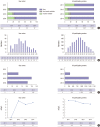Real-time Data Display System of the Korean Neonatal Network
- PMID: 26566352
- PMCID: PMC4641057
- DOI: 10.3346/jkms.2015.30.S1.S12
Real-time Data Display System of the Korean Neonatal Network
Abstract
Real-time data reporting in clinical research networks can provide network members through interim analyses of the registered data, which can facilitate further studies and quality improvement activities. The aim of this report was to describe the building process of the data display system (DDS) of the Korean Neonatal Network (KNN) and its basic structure. After member verification at the KNN member's site, users can choose a variable of interest that is listed in the in-hospital data statistics (for 90 variables) or in the follow-up data statistics (for 54 variables). The statistical results of the outcome variables are displayed on the HyperText Markup Language 5-based chart graphs and tables. Participating hospitals can compare their performance to those of KNN as a whole and identify the trends over time. Ranking of each participating hospital is also displayed in terms of key outcome variables such as mortality and major neonatal morbidities with the names of other centers blinded. The most powerful function of the DDS is the ability to perform 'conditional filtering' which allows users to exclusively review the records of interest. Further collaboration is needed to upgrade the DDS to a more sophisticated analytical system and to provide a more user-friendly interface.
Keywords: Data Display System; Korean Neonatal Network; Quality Improvement.
Conflict of interest statement
Figures





References
-
- Hack M, Horbar JD, Malloy MH, Tyson JE, Wright E, Wright L. Very low birth weight outcomes of the National Institute of Child Health and Human Development Neonatal Network. Pediatrics. 1991;87:587–597. - PubMed
-
- Horbar JD. The Vermont-Oxford Neonatal Network: integrating research and clinical practice to improve the quality of medical care. Semin Perinatol. 1995;19:124–131. - PubMed
-
- Shah PS, Lee SK, Lui K, Sjörs G, Mori R, Reichman B, Håkansson S, Feliciano LS, Modi N, Adams M, et al. The International Network for Evaluating Outcomes of very low birth weight, very preterm neonates (iNeo): a protocol for collaborative comparisons of international health services for quality improvement in neonatal care. BMC Pediatr. 2014;14:110. - PMC - PubMed
-
- Thakkar M, O'Shea M. The role of neonatal networks. Semin Fetal Neonatal Med. 2006;11:105–110. - PubMed
-
- Horbar JD, Soll RF, Edwards WH. The Vermont Oxford Network: a community of practice. Clin Perinatol. 2010;37:29–47. - PubMed
Publication types
MeSH terms
LinkOut - more resources
Full Text Sources

